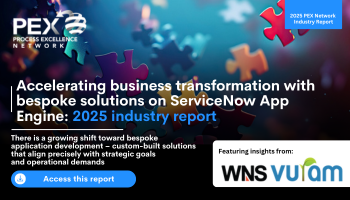What is intelligent automation?
Learn what intelligent automation is, the technologies it encapsulates and how to apply them to improve operational efficiency
Add bookmark
Intelligent automation (IA) is a combination of business process management (BPM) methodology and software, machine learning (ML), artificial intelligence (AI), data analytics and process mining. When all orchestrated together, these technologies allow businesses to map out and analyze internal processes to remove dependencies, identify process redundancies and make informed decisions on which processes to automate from an operational efficiency or return on investment (ROI) standpoint.
In this guide we explore the different elements of IA, its benefits and how to implement it, along with some real-world examples of companies that have successfully adopted IA into their processes.
Don't miss any news, updates or insider tips from PEX Network by getting them delivered to your inbox. Sign up to our newsletter and join our community of experts. Join the PEX Network community

Contents
- The components of intelligent automation
- The benefits of intelligent automation
- How to implement intelligent automation
- IA success stories
- Generative AI and its impact on intelligent automation
The components of intelligent automation
There are a number of components that fall under the umbrella of IA that used alone do not constitute an IA initiative, however the combination of these technologies and approaches allows organizations to automate intelligently.
Robotic process automation
Robotic process automation (RPA) is the application of ‘bots’ to perform certain mundane or repetitive tasks in an automated fashion, freeing up employees to work on more time-consuming or challenging ones. RPA offers other significant benefits such as the elimination of human error which in turn reduces costs associated with rework or correction.
Artificial intelligence and machine learning
According to PEX Network advisory board member Andrae Kirkland, AI is the idea that machines and computers can ‘think’, learning from experience and operating without explicit instructions.
AI and ML work together to push automation efforts into 'a new era' and ensure they can be considered truly intelligent. These technologies further reduce the need for human intervention in tasks that have been selected for automation.
They have the ability to identify process exceptions and deviations, to automatically learn from them, and make adjustments to enhance process efficiency for future interactions. For example, when combined with RPA, these technologies can drastically reduce handling time for business documents.
BPM
BPM is a process excellence methodology that has been a key topic in the process improvement discussion for many years now. BPM is a combination of practices and technologies from various disciplines that are deployed to discover, model, analyze, measure and optimize business processes. When deployed correctly BPM initiatives have the ability to enhance processes with regard to efficiency, efficacy and technical ability.

Process mining
Process mining is a combination of BPM and data mining approaches. There are four key stages that need to be carried out in a process mining initiative. These are collecting data on processes, discovering what the data says about these, enhancing the processes by removing friction points and finally monitoring the processes to observe results.
Process mining is carried out on event logs, which are time-stamped logs of process interactions throughout an organization, to provide a new level of visibility over how processes are being carried out in reality. This allows for the identification, and subsequent removal, of process bottlenecks or inefficiencies.

The benefits of intelligent automation
IA can improve operational efficiency
IA has the capability to enhance operational efficiency in several ways. By automating processes and having a ‘bot’ instead of a human completing tasks, organizations can save time and resources. While the automated task can be completed much faster, it also frees up employees to work on more challenging tasks that require the type of advanced reasoning that currently only a human can offer.
Global logistics company Maersk took the capabilities of automation even further with AI and ML. By embedding them into the cash collections process the organization implemented predictive capabilities to assess the level of risk in selecting customers.
This removes the guesswork from this process, allowing an immediate resolution, significantly enhancing efficiency and allowing organizations to effectively drive operational excellence.
IA can maximize business growth
IA technologies can be applied to maximize business growth when used to streamline financial processes such as procure-to-pay (P2P).
Applying ML to automatically capture purchase orders and invoices and converting them into the enterprise resource planning (ERP) system frees up the workers who would traditionally do this and enables a significant increase in overall processing. This facilitates successful scaling of business growth as it enhances an organization’s ability to deal with a large number of customers efficiently.

Automate at scale with IA
One of the greatest challenges associated with automation initiatives is the difficulty of scaling them up so that they can be applied across an entire organization. Initially, process excellence practitioners can struggle to justify investment in RPA initiatives as the routine tasks being automated are not a major part of overall processes and may be seen as extraneous to the core business needs.
IA can become critical as organizations begin to focus on larger automated initiatives as AI and ML have the ability to analyze organizational processes at a level humans are not capable of and provide unprecedented visibility over what is required to overhaul processes.

How to implement intelligent automation
Start with the process
When considering the breadth of IA technologies and the ways that they can be deployed, it can be difficult to know where to start. Kirkland advises to start with the process rather than the technology.
Instead of “grabbing for that shiny new piece of technology”, organizations should seek to understand where they are with regard to the state of their processes, what problems they are facing and trying to overcome, and how to separate the symptoms from the root cause.
Be outcome-focused
Implementing IA initiatives that integrate well with the organizational setup of systems and achieve the desired outcome can be a challenging task. In PEX Network’s Using intelligent process automation to build business resiliency report, it was identified that being outcome-focused is critical to ensuring the success of IA initiatives.
In the report, Lee Glazier, head of service integrity at Rolls-Royce, recommends that organizations avoid getting “too hung up on definitions for IA as it is more important that outcomes and governance drive the selection of the most appropriate tools”.
This means that IA technologies should be deployed with a clear goal in mind and to meet a specific need, rather than just being added for the sake of acquiring the latest technology. Once an organization has taken steps to understand what its primary needs and goals are, then IA technologies and practices can be selected to meet those specific needs.

Integrate IA technologies with legacy systems
When implementing IA, PEX practitioners should consider what legacy systems their organization has in place and whether these systems will remain in place in the long term or if they will eventually be replaced.
If the organization has a long-term roadmap for the utilization of the legacy systems then IA can be implemented immediately, as long as it is orchestrated around the capabilities and limitations of these systems.
If there are plans to update legacy systems with more modern technologies, then organizations should not rush to implement IA as they will first need to consider if and how these technologies will facilitate IA, and develop a strategy for their implementation, which can be a difficult process.

IA success stories
How Spotify implemented 100 bots in less than 18 months
Spotify took steps to implement automated initiatives across the organization and had an enormous amount of success, resulting in the generation of 100 bots in less than 18 months, all managed by a Center of Excellence (CoE) team of less than 10 people.
The impact of this success on the efficiency of the organization was enormous, with Sidney Madison Prescott, global head of intelligent automation at Spotify, claiming that the initiative has saved over 30,000 hours of employee time through these automated bots.

Driving asset turnover gains at Nokia
Nokia took steps to implement IA technologies to automate the processing of customer purchase orders. The global telecommunications organization applied a combination of practices including BPM, RPA, natural language processing and intelligent data extraction.
The automated process, other than yielding superb asset turnover gains and cost efficiencies, reduced the purchase order processing turnaround time to a fraction of what it was previously and accelerated customer fulfilment.
Generative AI and its impact on intelligent automation
Looking ahead, intelligent automation will become increasingly sophisticated and integrated with other advanced technologies.
The emergence of generative AI in particular can enable intelligent automation systems to handle complex tasks that require human-like decision-making. For example, in the case of engineering or optimization problems it can help to automate problem-solving by generating solutions that meet specific criteria.
Organizations can also leverage generative AI to reduce their time-to-market, by speeding up content creation for marketing and visual elements for websites.
Additionally, generative AI models that are constantly being trained on data can help to drive continuous improvement initiatives.
As generative AI technologies mature and become more accessible, they will democratize the ability to create and innovate, especially for small businesses and individuals. Here the use of generative AI combined with automation will enable them to improve their productivity and processes, while keeping costs to a minimum.
Accelerating business transformation with bespoke solutions on ServiceNow App Engine

Today, off-the-shelf software solutions offer diverse features that enable vast opportunities to implement and maintain business transformation. However, in some circumstances, capabilities lack the flexibility and specificity required to address the unique challenges and workflows of individual organizations. As a result, there is a growing shift toward bespoke application development – custom-built solutions that align precisely with strategic goals and operational demands.
Download this report to explore how enterprises can harness the power of custom applications to drive meaningful transformation. With the growing adoption of low-code platforms like ServiceNow App Engine, organizations are building custom applications faster and with greater control. By empowering both IT professionals and citizen developers to build tailored solutions, organizations can significantly reduce time to value while maintaining control over quality and compliance.
Download NowThis article was originally published on February 7, 2022 and updated on April 4, 2024.























